#he's been in the 1940s and the 1910s and the 1980s and the 1990s. soon to include the 1860s
Text





part of anthony boyle's interview with WWD - Women's Wear Daily
#'i think i've got a face that just looks like it can't comprehend the internet' priceless!#also very funny bc MotA is actually the 2nd 1940s ww2 miniseries i've seen him in (everyone go watch the plot against america right Now)#he's been in the 1940s and the 1910s and the 1980s and the 1990s. soon to include the 1860s#i wanna see him in something set in the 1920s or the 1700s or hell. let's take it back to the middle ages lol i'm not picky!#masters of the air#hbo war#interview#anthony boyle
108 notes
·
View notes
Text
GUM MACHINE
April 8, 1949
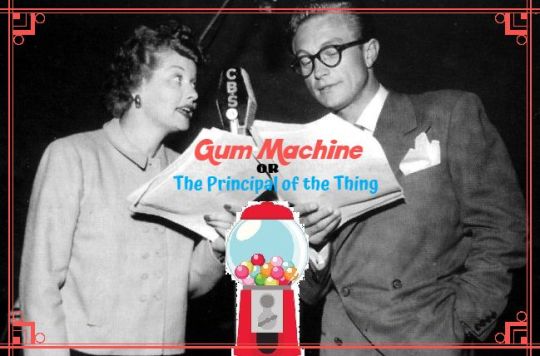
“Gum Machine” (aka “The Principal of the Thing” aka “Demand Your Rights”) is episode #38 of the radio series MY FAVORITE HUSBAND broadcast on April 9, 1949 on the CBS radio network.
Synopsis ~ George tells Liz that she needs to stand up for her rights and stop letting people push her around. So when Liz loses a penny in a broken gum machine, she vows to get her penny back no matter what the cost.

“My Favorite Husband” was based on the novels Mr. and Mrs. Cugat, the Record of a Happy Marriage (1940) and Outside Eden (1945) by Isabel Scott Rorick, which had previously been adapted into the film Are Husbands Necessary? (1942). “My Favorite Husband” was first broadcast as a one-time special on July 5, 1948. Lucille Ball and Lee Bowman played the characters of Liz and George Cugat, and a positive response to this broadcast convinced CBS to launch “My Favorite Husband” as a series. Bowman was not available Richard Denning was cast as George. On January 7, 1949, confusion with bandleader Xavier Cugat prompted a name change to Cooper. On this same episode Jell-O became its sponsor. A total of 124 episodes of the program aired from July 23, 1948 through March 31, 1951. After about ten episodes had been written, writers Fox and Davenport departed and three new writers took over – Bob Carroll, Jr., Madelyn Pugh, and head writer/producer Jess Oppenheimer. In March 1949 Gale Gordon took over the existing role of George’s boss, Rudolph Atterbury, and Bea Benaderet was added as his wife, Iris. CBS brought “My Favorite Husband” to television in 1953, starring Joan Caulfield and Barry Nelson as Liz and George Cooper. The television version ran two-and-a-half seasons, from September 1953 through December 1955, running concurrently with “I Love Lucy.” It was produced live at CBS Television City for most of its run, until switching to film for a truncated third season filmed (ironically) at Desilu and recasting Liz Cooper with Vanessa Brown.
MAIN CAST
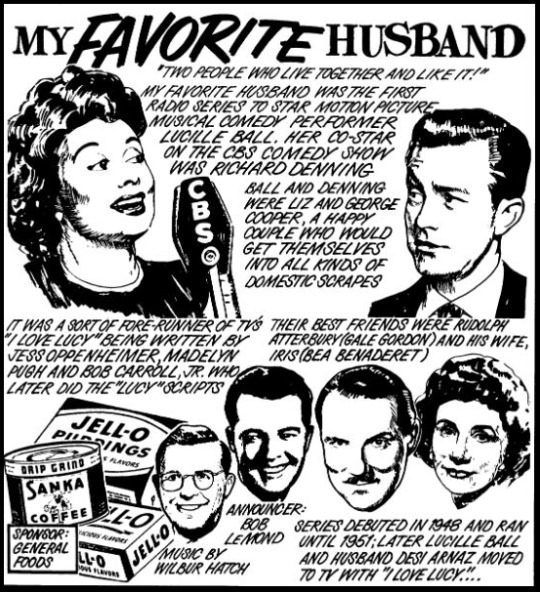
Lucille Ball (Liz Cooper) was born on August 6, 1911 in Jamestown, New York. She began her screen career in 1933 and was known in Hollywood as ‘Queen of the B’s’ due to her many appearances in ‘B’ movies. With Richard Denning, she starred in a radio program titled “My Favorite Husband” which eventually led to the creation of “I Love Lucy,” a television situation comedy in which she co-starred with her real-life husband, Latin bandleader Desi Arnaz. The program was phenomenally successful, allowing the couple to purchase what was once RKO Studios, re-naming it Desilu. When the show ended in 1960 (in an hour-long format known as “The Lucy-Desi Comedy Hour”) so did Lucy and Desi’s marriage. In 1962, hoping to keep Desilu financially solvent, Lucy returned to the sitcom format with “The Lucy Show,” which lasted six seasons. She followed that with a similar sitcom “Here’s Lucy” co-starring with her real-life children, Lucie and Desi Jr., as well as Gale Gordon, who had joined the cast of “The Lucy Show” during season two. Before her death in 1989, Lucy made one more attempt at a sitcom with “Life With Lucy,” also with Gordon.
Richard Denning (George Cooper) was born Louis Albert Heindrich Denninger Jr., in Poughkeepsie, New York. When he was 18 months old, his family moved to Los Angeles. Plans called for him to take over his father’s garment manufacturing business, but he developed an interest in acting. Denning enlisted in the US Navy during World War II. He is best known for his roles in various science fiction and horror films of the 1950s. Although he teamed with Lucille Ball on radio in “My Favorite Husband,” the two never acted together on screen. While “I Love Lucy” was on the air, he was seen on another CBS TV series, “Mr. & Mrs. North.” From 1968 to 1980 he played the Governor on “Hawaii 5-0″, his final role. He died in 1998 at age 84.
Gale Gordon and Bea Benadaret do not appear in this episode.
Ruth Perrott (Katie, the Maid) was also later seen on “I Love Lucy.” She first played Mrs. Pomerantz (above right), a member of the surprise investigating committee for the Society Matrons League in “Pioneer Women” (ILL S1;E25), as one of the member of the Wednesday Afternoon Fine Arts League in “Lucy and Ethel Buy the Same Dress” (ILL S3;E3), and also played a nurse when “Lucy Goes to the Hospital” (ILL S2;E16). She died in 1996 at the age of 96.
Bob LeMond (Announcer) also served as the announcer for the pilot episode of “I Love Lucy”. When the long-lost pilot was finally discovered in 1990, a few moments of the opening narration were damaged and lost, so LeMond – fifty years later – recreated the narration for the CBS special and subsequent DVD release.
GUEST CAST
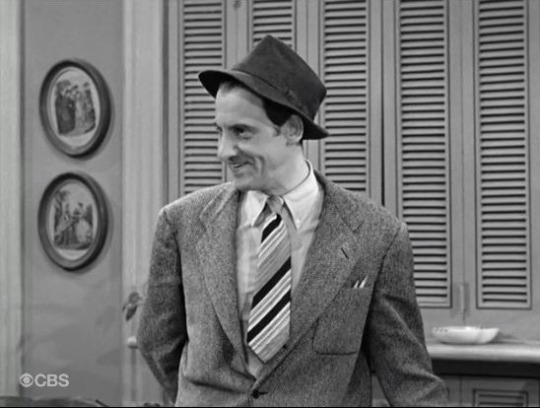
Hans Conried (Milkman / Eddie) first co-starred with Lucille Ball in The Big Street (1942). He then appeared on “I Love Lucy” as used furniture man Dan Jenkins in “Redecorating” (ILL S2;E8) and later that same season as Percy Livermore in “Lucy Hires an English Tutor” (ILL S2;E13) – both in 1952. The following year he began an association with Disney by voicing Captain Hook in Peter Pan. On “The Lucy Show” he played Professor Gitterman in “Lucy’s Barbershop Quartet” (TLS S1;E19) and in “Lucy Plays Cleopatra” (TLS S2;E1). He was probably best known as Uncle Tonoose on “Make Room for Daddy” starring Danny Thomas, which was filmed on the Desilu lot. He joined Thomas on a season 6 episode of “Here’s Lucy” in 1973.

Frank Nelson (Cop on the Beat) was born on May 6, 1911 (three months before Lucille Ball) in Colorado Springs, Colorado. He started working as a radio announcer at the age of 15. He later appeared on such popular radio shows as “The Great Gildersleeve,” “Burns and Allen,” and “Fibber McGee & Molly”. This is one of his 11 performances on “My Favorite Husband.” On “I Love Lucy” he holds the distinction of being the only actor to play two recurring roles: Freddie Fillmore and Ralph Ramsey, as well as six one-off characters, including the frazzled train conductor in “The Great Train Robbery” (ILL S5;E5), a character he repeated on “The Lucy Show.” Aside from Lucille Ball, Nelson is perhaps most associated with Jack Benny and was a fifteen-year regular on his radio and television programs.
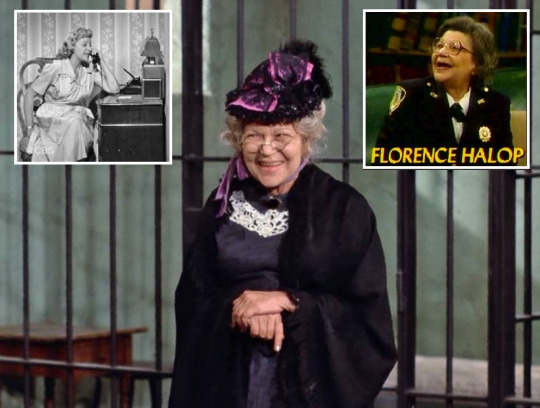
Florence Halop (”The Brooklyn Blabbermouth” aka “Nasal Hazel”) was first seen on television with Lucille Ball in “Redecorating” (ILL S2;E8) in which she reprised her role as the party line phone hog. She wouldn’t work for Lucy again until 1974, when she played a Little Old Lady on a Western-themed episode of “Here’s Lucy.” In 1985, she replaced Selma Diamond (who had died of lung cancer) as the bailiff on “Night Court.”

Johnny McGovern (Boy) was just 13 years old when he did this episode. During this time he also played Little Beaver on the radio series “Red Ryder”. He was eventually replaced by Sammy Ogg, who played one of the Hudson Twins on “I Love Lucy.” On television, he played Will Thornberry in four episodes of “The Adventures of Ozzie and Harriet” from 1953 to 1955.
EPISODE
ANNOUNCER: “As we look in on the Coopers today, it is breakfast time and at the table a little domestic drama is taking place. George is engrossed in the morning paper and Liz finds herself sitting there with no one to talk to. This of course is a scene, which never happens in any other home. One thing about George though, no matter how interested he is in the paper when Liz speaks he comes right to attention.”

George doesn’t respond when Liz asks for a morning kiss. She lights his newspaper on fire!
Lucy Ricardo also did this to get Ricky’s attention in “Be a Pal” (ILL S1;E2).
LIZ: “Ever since spring training started there are eleven of us at breakfast: you, me, and the Dodgers.”
George promises to put the paper down... as soon as he finishes the article about golf and Demeret.
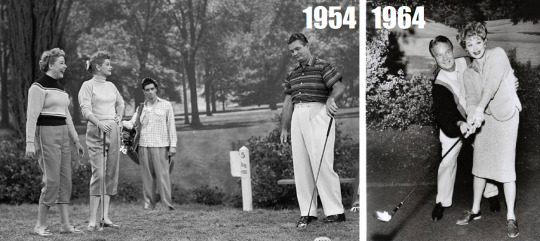
Golf pro Jimmy Demaret (1910-83) appeared as himself on “I Love Lucy” in 1954, then again on “The Lucy Show” in 1964. In real life, Lucille Ball and her husbands Desi and Gary were golfers.
Liz begs him for a kiss, and without paying much attention, he complies. Instead of her lips, he has kissed Liz’s morning grapefruit without even noticing!
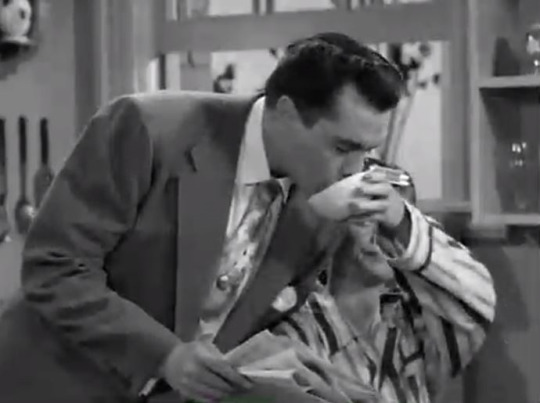
Lucy Ricardo also did this to Ricky in in “Be a Pal” (ILL S1;E2).
Liz begs him for a favor: tell Katie the maid she cannot have Saturday night off. They have guests coming, and Liz was afraid to ask for herself. George asks her himself, and Katie isn’t bothered at all. Liz agrees that from now on she’ll stand up for her rights.
When George finds the cream for the coffee has soured, he insists Liz tell the milkman about it - stand up for her rights. The milkman arrives, delivers the milk, and then leaves. Liz chickened out. George calls him back to tell him Hogan’s Frolicking Milkmaid Cream was sour. The milkman (Hans Conried) says that Mr. Hogan will take it out on the cow! He gives them free items instead of losing their business.
MILKMAN: “You see, we can’t afford a radio program!”

It was common that large companies would sponsor radio programs, their names becoming part of the title, and the stars doing live commercials for them. Pet and Carnation were two of the most ubiquitous dairy sponsors on radio.
While downtown shopping with Katie, Liz is bragging about how she told off the butcher. She stops for a piece of gum from a gumball machine. It takes her penny, but doesn’t give her any good. Liz is angry. A crowd gathers, including a cop (Frank Nelson). He says that someone has been robbing the machines of their pennies, and wants to know if Liz knows anything about it.
LIZ: “Yeah, I’m the ring leader: Two-Gun Jean the Chicle Queen!”

Chicle is a natural gum traditionally used in making chewing gum and other products. The American Chicle Company was an American chewing gum company, incorporated in 1899. Its products eventually grew to include breath mints, antacids, cough drops and other items. American Chicle was acquired by Warner-Lambert in 1962, which in turn was acquired by Pfizer in 2000.
Liz demands to know the name of the company who owns the ‘one-finger bandit’.
When she gets home she finds their phone number for the Ballyhoo Vending Machine Company. When she tries to call, the ‘Brooklyn Blabbermouth’ aka ‘Nasal Hazel’ (Florence Halop) is on the party line, talking to her boyfriend, Eddie.
ANNOUNCER: “Liz is embarking on a battle for her rights with the Ballyhoo Vending Machine Company. As we find her now, she is on her way to do battle, and George is dropping her off in front of the vending machine company.”
George needs to visit the bank, so he says he will meet Liz in an hour for lunch at Nickodells.
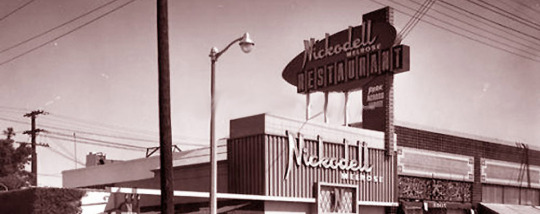
Nickodell Restaurant was located at 5511 Melrose Avenue, built into the side of RKO (later Desilu) Studio. Nickodell was the place folks working on the lot escaped to for a mid-day cocktail, and many important deals were made at its tables. When “I Love Lucy” was casting Desi Arnaz got a call from an actor named William Frawley and they arranged to get together and discuss the role over drinks at Nickodell. It closed for good in 1993.
GEORGE: “So long, Carrie Nation!”
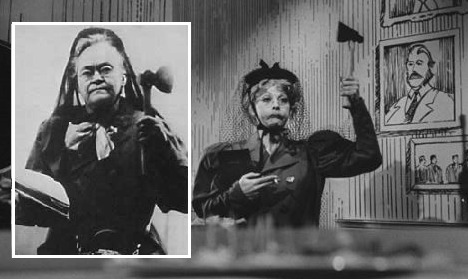
Caroline Amelia Nation (1846-1911) was an activist who was a radical member of the temperance movement, which opposed alcohol before the advent of Prohibition. Nation is noted for attacking alcohol-serving establishments (most often taverns) with a hatchet. Lucille Ball played Nation in a sketch in 1962′s “The Good Years” on CBS TV.
Liz enters the ‘crooked’ gum machine company, and demands to see the complain manager. It is ‘the Brooklyn Blabbermouth’! Despite their differences, Liz tells her that she wants her penny back.
BLABBERMOUTH: “Why you so in love with that penny? Did Lincoln give it to you personally?”
Rather than fill out a refund form (which asks for her birth year) she vows to hire a lawyer to get her refund.
LIZ: “I’ll get that penny back if it takes every cent I’ve got!”

On her way to lunch, she sees a little boy (Johnny McGovern) crying that he isn’t tall enough to reach the gum machine! She tries to convince him he’s better off short! She agrees to put his penny into the machine to get him a piece of gum. Naturally, no gum comes out. She doesn’t have another penny of her own. The little boy tells her to hit it on the side. She does and a flood of pennies spill out on the sidewalk. They both take a penny for their refunds. The cop finds them standing in a pile of pennies. He accuses her of being the ring leader, just as sarcastically said earlier.
COP: “You’re going to jail, Mrs. Fagin!”

The name ‘Fagin’ was borrowed from the Charles Dickens’ 1838 novel Oliver Twist. In the preface to the novel, he is described as a "receiver of stolen goods”. He is the leader of a group of child pickpockets and prostitutes. Alec Guinness portrayed Fagin in David Lean’s 1948 film adaptation of Oliver Twist, The release of the film in the USA was delayed for three years on charges of being anti-Semitic. It was finally released in the United States in 1951. Fagin will also be mentioned in “Liz and Iris’s Easter” (March 24, 1951), in a scene also featuring Frank Nelson!
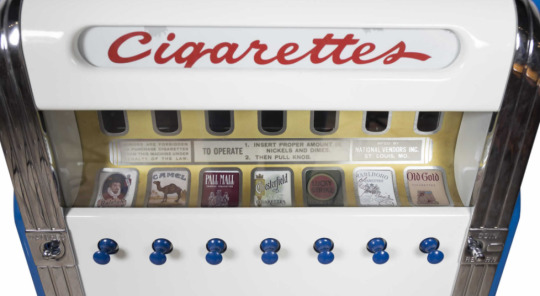
Later, George has paid $50 bail to get Liz out of jail, and is not happy about it. Liz jollies him into kissing him - in the middle of the street. Before going home, George wants to get some cigarettes - from a machine! Naturally, no cigarettes come out. Just when George is jiggling the handle, you-know-who comes by!
COP: “Well, if it isn’t Mrs. Fagin. I see you’re working with older boys now.”
He arrests them both!
End of Episode
#Gum Machine#Lucille Ball#My Favorite Husband#Frank Nelson#Hans Conried#Florence Halop#Ruth Perrott#CBS Radio#Richard Denning#Johnny McGovern#vending machine#Fagin#Carrie Nation#Nickodell#Jimmy Demaret#Chicle#Gum#I Love Lucy#The Lucy Show#newspapers#1949
1 note
·
View note
Text
A Century of Glamour Ghouls: 1960s
Marianne Danielle in The Brides of Dracula (1960)

The Movie
Sometime in the late 19th century, somewhere east of France, those damned dapper, aristocratic vampires are at it again. Two years after Horror of Dracula (1958) was a smash hit for Hammer Film Productions, The Brides of Dracula (1960) was produced. Dracula didn’t rise from the grave for this one, but Van Helsing continues on his quest to wipe out his blood-sucking kin.
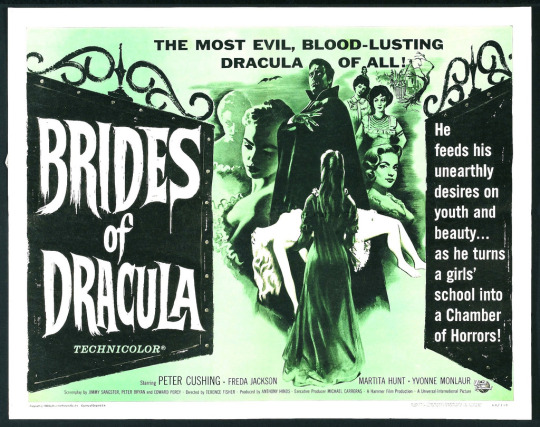
The film begins when Marianne Danielle (Yvonne Monlaur), a deportment teacher from Paris, encounters coach trouble en route to a new job. Stranded at the village inn, Marianne meets the Baroness Meinster who invites her to stay the night at her chateau. Marianne soon discovers that the Baroness has been keeping a secret; the Baroness’ “ill” son is locked up in his own wing of the chateau. Misunderstanding the nature of the Baron’s affliction Marianne executes a plan to set him free. The Baron then murders his own mother before escaping into the night. Marianne, distraught at being left behind, flees through the woods where she is found in passed out in shock and exhaustion by Dr. Van Helsing, who is investigating rumors around the Meinster family. A rash of strange murders break out in the village and Van Helsing closes in on the Baron. Unbeknownst to Van Helsing, Marianne has agreed to marry the Baron, still not aware that he is a vampire.
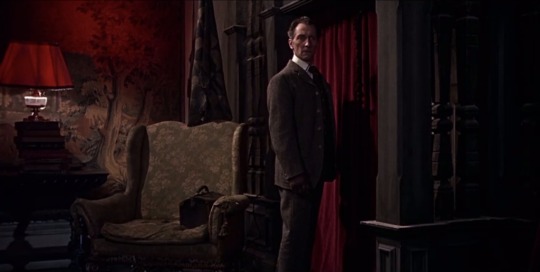
When Hammer began producing their own set of adaptations of the classic movie monsters, they established a colorful gothic universe that stretched well beyond the initial characters, scenarios, and stories. Brides sets the tone for all of the Hammer vampire films that followed. They’re stylish period pieces, though which period can be a little muddy giving the films an added fantastical quality. They have a pronounced gothic flair.

While no Hammer film is absent of camp, their first decade of horror was a bit more reserved in style and content. Hammer bucked censors from the start with The Quatermass Xperiment (1955) when they not only didn’t fret an X rating, but changed the title of the film to publicize that X. It wouldn’t be until the end of the 1960s that Hammer would push for the pulpy provocative content, nudity, and lesbianism closely associated with the later Hammer vampire films, but the seeds for that progression (or regression depending on how you look at it) are already visible in Brides.

The Look
A hallmark of Hammer horror is glossy glam taking precedent over historical accuracy in costuming and makeup design. Marianne is no exception.

The Clothes
The film is roughly set at the end of the 19th century and Marianne’s costuming doesn’t reflect that exactly but it’s quite consistent throughout the film.
Marianne is always in long dresses, with long tapered sleeves and puffy shoulders. Most of her collars make a high v. Marianne is often costumed in deep colors (warm grey with red detailing, forest green, crimson, etc.) and velvety fabrics.

This contrasts her from the Meinsters, who are typically costumed in cool grayish and purple shades and often in fussier fabrics like silk and embellished lace.

(In addition, when people encounter the Baron for the first time either to get vamped or put in his thrall, they’re usually wearing a cool purple shade.)

She also has the best winter coat I’ve ever seen in my life and if anyone knows where I can get this exact coat HMU.

For the daytime look, I wanted to translate the Marianne costuming philosophy into something more contemporary. I didn’t succeed very well with colors, but hey. I chose a knit button-up top with lace detailing and a little puff at the sleeves and a velvet mini skirt. To add some deep colors to the look, I wore purple tights (though the camera didn’t pick up the hue well).
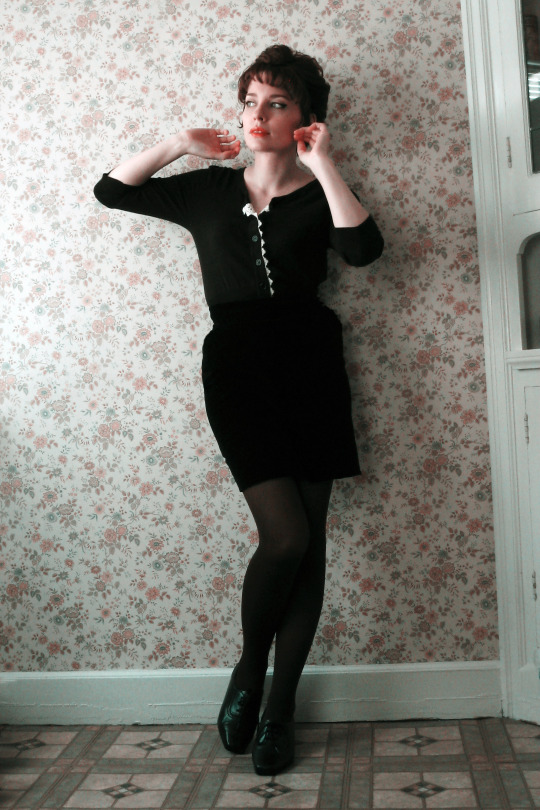
For the full cosplay, I stuck with a velvet skirt (ideally it’d be ankle-length, but I don’t have many ankle-length skirts). This time I paired it with a cream-colored high-necked blouse under a black fitted blazer that I tucked into the skirt, trying to mimic the style of dress Marianne wears in the film. On top of that, I added a plaid capelet with brown and white detailing and white scarf.
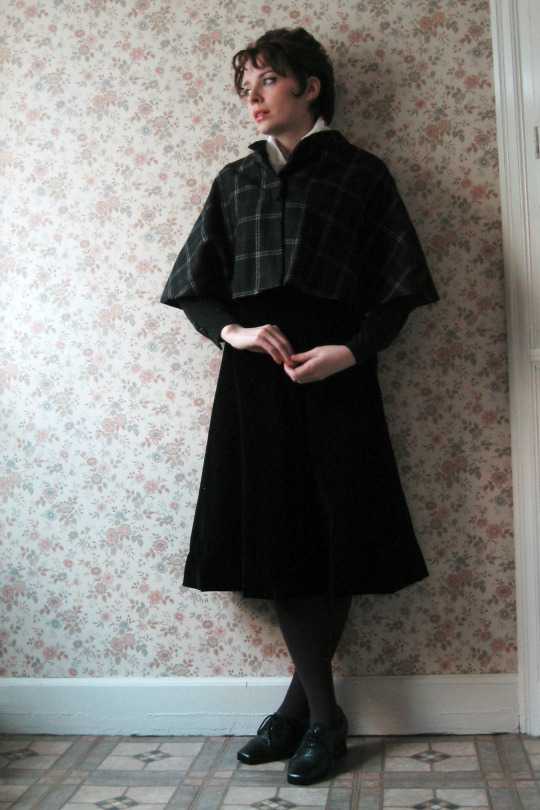
Recreating Marianne’s look simply from my own closet was easier said than done. If you’d like to be a generic woman from Hammer horror, era-appropriate dresses are usually easy to find in vintage stores and could be paired with the makeup below. Case in point, me on Halloween 3 years ago:
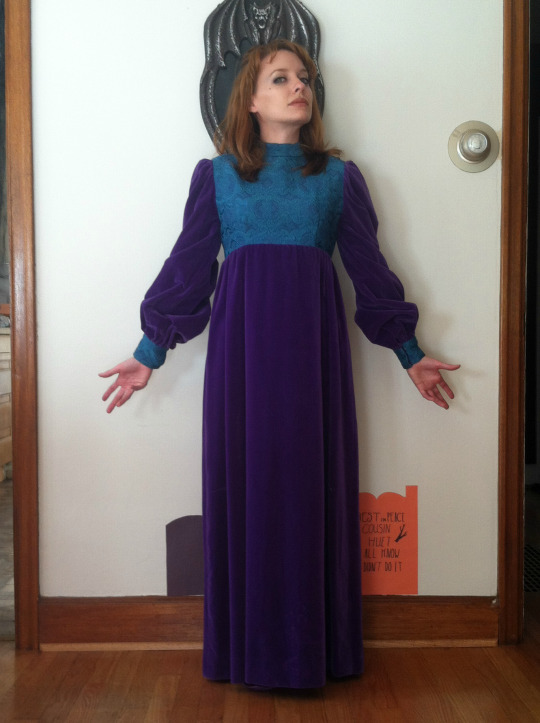
The Makeup
Marianne’s makeup is definitely a look that could pass for modern, so I’ll only do a single face for both levels of cosplay. It’s a high-contrast look but with warm, romantic colors. A great look for autumn to be honest.

Start with an even base with a natural or semi-matte finish. Cover your lids with a neutral shade either in your skin tone or one shade lighter.
Take a neutral or warm purple shade into the crease and outer edge of your lid and blend up. Follow that up with a lighter shade on the lid and just below the brow to create contrast; I chose a pale yellow.

The liner is pretty intense so if you need extra guidance on wings, I talked covered my method in the 1950s. (1.) Start with a thin line of eyeliner right at the lashline. (2.) With your eyes open, looking straight into the mirror, draw out an upward swinging triangle on the outside of your eye and fill it in. (3.) Take a thin angled brush with black or dark brown shadow, smooth the liner and connect the wing with your lower lashline with what is left on the brush. (4.) Finish the eyes up with a few coats of black mascara and, if you like, go into the upper waterline with black liner.

Contouring wasn’t big in 1960, but sculpting with blush certainly was. Take a warm blush and go over the tops of your cheekbones and below them all the way to your ear.

Marianne’s eyebrows are strong but relatively straight. I took a warm brown pencil to draw out the whole shape then softened it with light brown powder and a clean spoolie.
Go back into your eyeliner and, with a small pointed brush place a beauty mark on top of your left cheekbone but below your eye.

Marianne’s lips are full and overlined a little to soften the lipline. Go in with a coral pink liner and round out the shape of your upper lip, particularly making sure the cupid’s bow is obscured. On the bottom lip, draw inward a little at the edges to focus the fullness on the middle of your lip. Then fill in your lips with a glossy coral pink lipstick or lipgloss if you feel that it’s too much with the eyes and cheeks.

If you wanted to glam it up further, long wispy false lashes would be perfect.

If you have the hair to properly recreate Marianne’s style, this Loepsie tutorial will serve you well.
The 1910s | The 1920s | The 1930s | The 1940s | The 1950s | The 1970s | The 1980s | The 1990s | The 2000s
#A Century of Glamour Ghouls#horror#horror movies#horror film#hammer films#hammer horror#the brides of dracula#brides of dracula#yvonne monlaur#British film#movie#film#classic film#glamour#glam#vintage#vintage inspired#true vintage#1960s#1960s fashion#1960s movies#makeup#makeup tutorial#fashion#halloween#halloween costumes#closet cosplay#instructional#costume#cosplay
269 notes
·
View notes
Text
Coin Finds: If you want it, you can find it
Based on the long-running “Coin Finds” column in Coins Magazine, which will continue to appear in print, this online version will give additional exposure to the thrill of the hunt.
Submit your own discoveries via email to David C. Harper at [email protected].
I’ve been a collector, off and on, for probably 30 years now, starting at a pretty young age. My grandpa originally got me interested in coins, and over the years I’ve gone down different paths as far as what I collected. I’ve always made sure to check my change, though. In recent years, it has seemed much more difficult to find anything, especially the older silver coins, but yesterday while grabbing lunch in downtown Cedar Rapids, I discovered a 1948-S dime in my change! So I guess there are still finds to be had!
Mark S
via email.
I’m a long-time collector for 50-plus years, and I still buy rolls and pick up change in parking lots to keep looking for gems. I bought two rolls of cents last hunt and found one wheat cent, 1957-D, and a 1998 Wide AM variety cent in AU condition. Then I went to Walmart and found two coins in the Coinstar reject slot, a 2001 Canadian quarter and a 2009 South Korean coin about the same size. All in one week. I’ll keep looking. They are still out there. Even free ones!
Gene K.
Southern Minnesota
Here is an unusual one:
An elderly friend of mine told me he had “some old coins” from the U.S. Mint and asked if I would look at them and maybe sell them for him. I said sure, and the next day he handed me two small, heavy cardboard packages, both from the U.S. Mint in Philadelphia, one from 1961 and the other from 1962. He had been sitting on them for 57 and 56 years without opening them! I opened the 1961 package carefully, and stuffed inside were 25 Proof sets of the usual penny, nickel, dime, quarter, and half. All 25 were in sealed brown envelopes. Ditto for the 1962 carton, 25 more.
Initial selling price back in the day was $2.10, so he paid $52.50 twice to get two boxes that have been untouched for over half a century.
I checked with four Indiana dealers, and the best price I was offered is $14.50 per set, for all 50 sets. I’m a bit disappointed, as my two-year-old Blue Book says $18, but then again, $725 is not a bad return for two boxes that sat in a drawer for 57 and 56 years! Deal struck, and now my friend has a check for $725.
Steve B.
Fishers, Ind.
I’ve only been a serious coin collector for maybe one or two years now. I collect for the historic value, and investment, and just the fun of finding coins of interest or value. So to make a long story short, I called my bank looking for Kennedy halves and Eisenhower dollars. The manager at my bank told me to go to another branch, as they had a couple of Eisenhowers. Went over and, to my amazement, they handed me two rolls of uncirculated Eisenhower dollars! What a find! All were Bicentennial dollars, too! Just goes to show you, if you want it, you can find it.
Jim B.
Tonawanda, N.Y.
P.S. My daughter shares the same interest in coin collecting as I do, probably because I give her doubles of what I have collected, but she has a very nice collection herself.
I very much enjoy your magazine, especially the “Coin Finds” section. I haven’t had as much luck or success in finding hard-to-find items as some of the other readers have, but I’m still searching.
My youngest son, who has no real interest in the hobby, has brought me coins on occasions. On one such occasion, he called me from his job and asked if coins are counterfeited. I told him if there is some value to the coin, some people will try.
He proceeded to describe a quarter he had come across at work. I asked a few questions and told him to swap it out and bring it to me if he could. A few hours later, he showed it to me.
It turned out to be a 2005 Minnesota state silver proof quarter. This was a big surprise. It had been circulated for some time, by the scratches and blemishes on it, but still had some mint proof luster to it.
On another occasion, a couple of weeks later, my son brought home six Teddy Roosevelt presidential dollar coins he received at work. They were bright, new, shiny coins that looked as though they just came out of the package. I don’t know how or why these coins were in circulation, but it’s pleasing that I was able to acquire them.
Good luck and happy hunting to all.
Joe S.
via email
I’ve enjoyed “Coin Finds” in this magazine for a while. I want to write about one of the most unusual finds I’ve ever made.
One morning in August of 2017, I decided to go to the store for some items. As I walked to the Coinstar machine, I could see some coins in the reject tray. I got everything out, which included (as I somewhat remember) two dimes, three pennies, and four foreign coins.
It’s normal to find foreign coins at the Coinstar machine, as it is calibrated to reject such coins. What was unusual, however, were the dates of these examples. They include (from most recent to earliest): 1979 Australian 10 cents (the size of a U.S. quarter), 1958 Mexican 5 Contavos (I like the brown color of it), 1950 German 1 Pfennig (the smallest of the group), and 1923 Canadian 5 cents (with King George V on the obverse).
This was definitely among my oddest coin finds, but still very exciting.
James
via email
I first wrote to Coins Magazine back in December of 2016 regarding Wheat back pennies and was pleasantly surprised that my letter, and finds were printed in the August 2017 edition. Since that letter, I have a new find to share with you. I call it “The Mother of All Finds…….EVER.” Well, at least it was to me. Here’s the back story:
My eldest son is not at all a coin collector, but rather the grandson and son of coin collectors. He has listened to me for countless hours ramble on about every aspect of coins and collecting coins for as long as I can remember, much of the time with two minutes of enthusiasm (then his eyes become glossed over from information overload). Hey, I understand that. I was the same way with my Dad years ago. However, something happened to him recently that made him change his outlook on his Grandfather’s and father’s passion. You can say HE STRUCK GOLD.
My son works for a house flipper and recently came across a small metal bank tucked away in the back of an old dresser in a house they were prepping for rehab. He took it to his boss and asked what he wanted to do with it. The boss said keep it and get back to work. So, he did just that. At the end of his work day, he decided to smash open his rehab find as clearly there were coins inside. How many, what kind, and what condition remained to be seen.
He called me two weeks after his discovery to tell me the story and what he found inside. As he began to describe each coin, it soon became clear to me that, condition notwithstanding, his find was not your average, everyday piggy bank variety. In fact, it was exemplary. Here is what was inside:
• Three each Walking Liberty Half Dollars dated: 1935, 1944 and 1947
• Nine each Mercury Head Dimes dated: 1920, 1926, 1936 (two), 1939 (two), 1940, 1942 and 1945
•Four Buffalo Head Nickels dated: 1934, 1937, and two unreadable dates
• Two Mexican Cinco Centavos dated: 1968 and 1969
• Nine Washington Quarters dated: 1936, 1942 (two), 1943 (two), 1944, 1949, 1954 and 1957
• Three Roosevelt Dimes dated: 1946, 1954, and 1957
• One Standing Liberty Quarter dated: unknown – worn off
• Six Jefferson Nickels dated: 1940, 1944 (two), 1947, 1948 and 1949
• One Canadian Penny dated: 1981
• Twenty Lincoln Head Pennies dated: 1959, 1962, 1964 (two), 1965, 1966, 1967, 1968 (four), 1969 (two), 1970 (two), 1971, 1980, 1983, 1984 and 1990
• Thirty-six Wheat Back Pennies dated: 1910, 1920, 1928, 1930, 1935, 1937, 1939 (three), 1940, 1941, 1942 (three), 1943, 1944 (four), 1945 (three), 1946 (two), 1947 (three), 1949, 1950 (two), 1951, 1952, 1953 (two), 1955 and 1957
And last but not least, the gem of the bunch: one Gold Liberty Head $5 piece dated: 1882
Few of these coins, all which were gifted to me by my son, have any higher grade than an EF, and most not even that. But the 1882 Gold Liberty Head has the highest grade of them all, with an estimate of AU-56-MS-61, in my humble opinion.
So is there a moral to this story? I’d say so. Involve your kids or grandkids at an early age by planting the seeds of knowledge and appreciation for the things you love most. Their eyes may soon gloss over, but I assure you, your passion means more to them than even THEY realize.
Happy hunting, everyone!
M.D.
Elgin, Illinois
Editor’s Note: Upon reading a recent blog post by my colleague and Numismatic News and World Coin News Editor Dave Harper, I thought it was a perfect fit for this space and a story many of you would enjoy.
I am eating too many lunches at McDonald’s these days.
I have become addicted to speed eating since we moved our office from Iola, Wis., to Stevens Point.
The franchise is handy. It is fast.
I get back to the office so I can work during the remaining portion of lunch hour.
How long I can keep this up is a good question, but it has been going long enough that I can now claim a circulation find in change.
Recently, I ordered three cheeseburgers off the Dollar Menu.
The bill came to $3.17.
I tendered a $20 bill.
The change came back in the form of three $5s and a $1 bill.
The 83 cents was made up of two quarters, three dimes and three cents.
I knew I had something as soon as I looked in my palm.
There was the unmistakable look of silver to one of the dimes.
My rational brain immediately kicked in.
“It can’t be. You haven’t gotten a silver dime in years.”
But it was silver. The unmistakable white color was obscured a bit by some light dirt or dried grease.
The dime will win no prizes for beauty or top grade, but the date is 1963.
Flipping it over, the mintmark to the left of the base of the torch was “D” for Denver.
Beyond the satisfaction of getting a silver coin was a sense of nostalgia for having to flip the coin over to see a mintmark on the reverse.
It is kind of fun to be successful in circulation finds mode.
I will report on the rest of the coins.
The other two dimes were 2006-P and 2008-P.
The three cents are a 1977-D, 1983-D and a 2013-D, reflecting the dominance of Denver coins here.
Two quarters are a very worn 1973-D and a 2014-P Arches America the Beautiful quarter.
Now I can hold my head up among the readers of Numismatic News who continue to scan their change and search bank rolls.
This article was originally printed in Coins Magazine. >> Subscribe today.
If you like what you’ve read here, we invite you to visit our online bookstore to learn more about Strike It Rich With Pocket Change.
Learn more >>>
The post Coin Finds: If you want it, you can find it appeared first on Numismatic News.
0 notes
Text
CHARITY REVUE
March 11, 1949

“Charity Revue” (aka “Red Cross Benefit Revue”) is episode #34 of the radio series MY FAVORITE HUSBAND broadcast on March 11, 1949 on the CBS radio network.
Synopsis ~ Mr. Atterbury asks George to work up a song and dance routine for the local Red Cross Charity Review. At the same time Liz’s women’s club recruits her to perform.

Note: This program was used as a basis for the “I Love Lucy” episode “The Benefit” (ILL S1;E13) filmed on November 30, 1951 and first aired on January 7, 1952.

“My Favorite Husband” was based on the novels Mr. and Mrs. Cugat, the Record of a Happy Marriage (1940) and Outside Eden (1945) by Isabel Scott Rorick, which had previously been adapted into the film Are Husbands Necessary? (1942). “My Favorite Husband” was first broadcast as a one-time special on July 5, 1948. Lucille Ball and Lee Bowman played the characters of Liz and George Cugat, and a positive response to this broadcast convinced CBS to launch “My Favorite Husband” as a series. Bowman was not available Richard Denning was cast as George. On January 7, 1949, confusion with bandleader Xavier Cugat prompted a name change to Cooper. On this same episode Jell-O became its sponsor. A total of 124 episodes of the program aired from July 23, 1948 through March 31, 1951. After about ten episodes had been written, writers Fox and Davenport departed and three new writers took over – Bob Carroll, Jr., Madelyn Pugh, and head writer/producer Jess Oppenheimer. In March 1949 Gale Gordon took over the existing role of George’s boss, Rudolph Atterbury, and Bea Benaderet was added as his wife, Iris. CBS brought “My Favorite Husband” to television in 1953, starring Joan Caulfield and Barry Nelson as Liz and George Cooper. The television version ran two-and-a-half seasons, from September 1953 through December 1955, running concurrently with “I Love Lucy.” It was produced live at CBS Television City for most of its run, until switching to film for a truncated third season filmed (ironically) at Desilu and recasting Liz Cooper with Vanessa Brown.
MAIN CAST
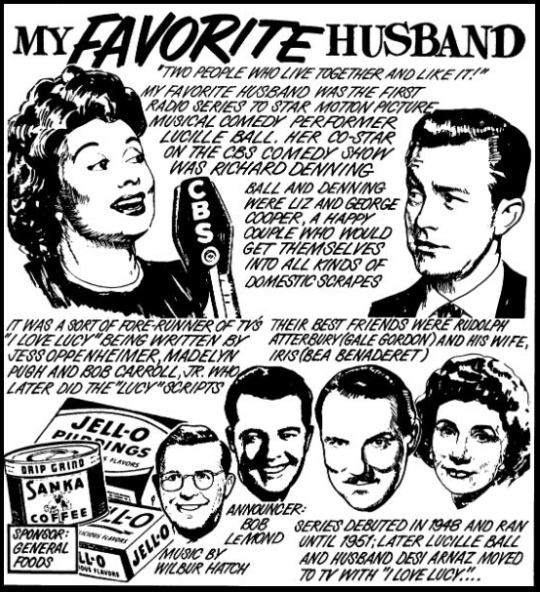
Lucille Ball (Liz Cooper) was born on August 6, 1911 in Jamestown, New York. She began her screen career in 1933 and was known in Hollywood as ‘Queen of the B’s’ due to her many appearances in ‘B’ movies. With Richard Denning, she starred in a radio program titled “My Favorite Husband” which eventually led to the creation of “I Love Lucy,” a television situation comedy in which she co-starred with her real-life husband, Latin bandleader Desi Arnaz. The program was phenomenally successful, allowing the couple to purchase what was once RKO Studios, re-naming it Desilu. When the show ended in 1960 (in an hour-long format known as “The Lucy-Desi Comedy Hour”) so did Lucy and Desi’s marriage. In 1962, hoping to keep Desilu financially solvent, Lucy returned to the sitcom format with “The Lucy Show,” which lasted six seasons. She followed that with a similar sitcom “Here’s Lucy” co-starring with her real-life children, Lucie and Desi Jr., as well as Gale Gordon, who had joined the cast of “The Lucy Show” during season two. Before her death in 1989, Lucy made one more attempt at a sitcom with “Life With Lucy,” also with Gordon.
Richard Denning (George Cooper) was born Louis Albert Heindrich Denninger Jr., in Poughkeepsie, New York. When he was 18 months old, his family moved to Los Angeles. Plans called for him to take over his father’s garment manufacturing business, but he developed an interest in acting. Denning enlisted in the US Navy during World War II. He is best known for his roles in various science fiction and horror films of the 1950s. Although he teamed with Lucille Ball on radio in “My Favorite Husband,” the two never acted together on screen. While “I Love Lucy” was on the air, he was seen on another CBS TV series, “Mr. & Mrs. North.” From 1968 to 1980 he played the Governor on “Hawaii 5-0″, his final role. He died in 1998 at age 84.
Gale Gordon (Rudolph Atterbury, George’s Boss) had worked with Lucille Ball on “The Wonder Show” on radio in 1938. One of the front-runners to play Fred Mertz on “I Love Lucy,” he eventually played Alvin Littlefield, owner of the Tropicana, during two episodes in 1952. After playing a Judge in an episode of “The Lucy-Desi Comedy Hour” in 1958, he would re-team with Lucy for all of her subsequent series’: as Theodore J. Mooney in ”The Lucy Show”; as Harrison Otis Carter in “Here’s Lucy”; and as Curtis McGibbon on “Life with Lucy.” Gordon died in 1995 at the age of 89.
This is Gordon’s first appearance as Rudolph Atterbury, a role previous played by Hans Conried.
Bea Benadaret does not appear in this episode.
Ruth Perrott (Katie, the Maid) was also later seen on “I Love Lucy.” She first played Mrs. Pomerantz (above right), a member of the surprise investigating committee for the Society Matrons League in “Pioneer Women” (ILL S1;E25), as one of the member of the Wednesday Afternoon Fine Arts League in “Lucy and Ethel Buy the Same Dress” (ILL S3;E3), and also played a nurse when “Lucy Goes to the Hospital” (ILL S2;E16). She died in 1996 at the age of 96.
Bob LeMond (Announcer) also served as the announcer for the pilot episode of “I Love Lucy”. When the long-lost pilot was finally discovered in 1990, a few moments of the opening narration were damaged and lost, so LeMond – fifty years later – recreated the narration for the CBS special and subsequent DVD release.
GUEST CAST

Gloria Blondell (Miss Marilyn Williams) was born to theatrical parents in New York City in 1910. She is the younger sister of Joan Blondell, also an actress. On radio, she did 26 episodes of seven different series. Blondell saw most of her work in the 1940s as the voice of Disney’s ‘Daisy Duck’ for Disney, doing six short films as Donald’s girlfriend. Blondell’s only screen collaboration with Lucille Ball was in “The Anniversary Present” (ILL S2;E3) in 1952, playing the Ricardo’s upstairs neighbor Grace Foster.
Giving the character the first name of Marilyn is no doubt meant to remind listeners of up-and-coming sex symbol Marilyn Monroe.

Gerald Mohr (Gerald Mohr) played psychiatrist Henry Molin, who masquerades as Ricky’s old friend Chuck Stewart in “The Inferiority Complex” (ILL S2;E18 ~ February 2, 1953), his only appearance on "I Love Lucy”. In return, Lucy and Desi appeared on his show “Sunday Showcase” that same year. He also made an appearance on “The Lucy Show” in “Lucy and Phil Harris” (TLS S6;E20 ~ February 5, 1968).
Mohr uses his own name for this appearance.
EPISODE
ANNOUNCER: “As we look in on the Coopers this morning, George is still upstairs getting dressed. Liz is in the kitchen, talking to Katie the Maid.”
Liz tells Katie that she’s excited for the upcoming Red Cross benefit. She is planning to do an act with George representing her club. The only detail is that she hasn’t told him about it yet!
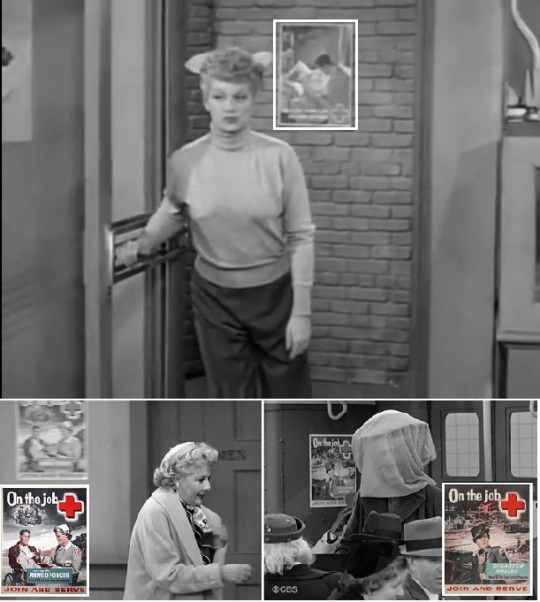
The Red Cross is a humanitarian organization founded in 1863 to protect human life and health, to ensure respect for all human beings, and to prevent and alleviate human suffering. American Red Cross posters were a favorite of the Desilu set decorators on “I Love Lucy”. They can be glimpsed in the subway during “Lucy and the Loving Cup” (ILL S6;E12), on the walls of the rented hall in “Ricky Has Labor Pains” (S2;E14), in the butcher shop in “The Freezer” (S1;E29), and on the Westport train station in “Lucy Misses the Mertzes” (S6;E17).
Liz goes into the dining room and sweet-talks George, covering him with kisses. He is immediately suspicious. Liz tells him that a woman in her club is doing an act with her husband for the Red Cross revue. George laughs and says the man will make a fool of himself - until Liz tells him that the man is him!
GEORGE: “You know if there’s one thing I hate more than that club of yours is amateur theatrics!”
Liz reminds him that he had the lead in his college musical and he was a big hit. She sings a few notes of “Boola Boola” to remind him.

"Boola Boola" is a football song of Yale University. The song was composed in 1900 and is generally attributed to Allan M. Hirsh, Yale Class of 1901. The song immediately caught on, soon being played by John Philip Sousa. It sold more sheet music in the first half of 1901 than any other song in the country, and became indelibly associated with Yale athletics. Is George a Yale man?
George is still reluctant, but Liz tries to convince him.
LIZ: “Jolson made a comeback. How about you?”

Al Jolson (1886-1950) was a Lithuanian-born singer, actor, and comedian. Unabashedly billed as the World’s Greatest Entertainer, Jolson was the most successful musical comedy star on Broadway in the 1910s and 1920s. He was also a major radio star and the most popular solo recording artist of the 1920s, his biggest hits being “Sonny Boy”, “April Showers,” and “Swanee.” He inaugurated sound motion pictures with The Jazz Singer (1927) and made a series of musical films. He enjoyed a spectacular career comeback in the years before his death, largely due to the film biographies The Jolson Story (1946) and Jolson Sings Again (1949). Jolson’s use of blackface, dating from his early years in minstrel shows, made him a controversial figure.
George refuses to give in.
At the bank, Mr. Atterbury calls George into his office. He tells George he should work up a song and dance routine with his wife to represent the bank in the Red Cross Revue. George says he can’t do it, but Mr. Atterbury threatens to demote him if he refuses. George admits defeat and reluctantly agrees.
Back at home, Liz hangs up the phone after telling her club the she won’t be doing the act after all. George comes home cheerfully singing “There’s No Business Like Show Business”.

“There’s No Business Like Show Business” is a song from Irving Berlin’s 1949 Broadway hit Annie Get Your Gun. It was introduced by Ethel Merman as Annie Oakley. In “Lucy Has Her Eyes Examined” (ILL S3;E11), Lucy Ricardo and the Mertzes burst into an rendition of the song as an impromptu audition for a Broadway producer. The song would also be quoted (not sung) by Lucy Ricardo in “Baby Pictures” (ILL S3;E5) and “Lucy Teaches Ethel Merman To Sing” (TLS S2;E18). Merman and the cast of “The Lucy Show” perform it in “Ethel Merman and the Boy Scout Show” (TLS S2;E19 ~ February 10, 1964).
GEORGE: “Hiya, Liz!”
LIZ: “Hiya, Bing.”
GEORGE: “How do the old pipes sound?”
LIZ: “Like they could use a little Drano.”

Liz is referring to singer, actor and comedian Bing Crosby, one of the biggest media stars of the 1940s. On “I Love Lucy” a Hollywood-bound Ricky called Crosby a bum - but dressed like him all the same. In “Lucy Takes a Cruise to Havana” (1957) Susie MacNamara tries to convince Lucy to become a Bing Crosby fan instead Rudy Vallee. Crosby’s name was mentioned on “The Lucy Show” and “Here’s Lucy.” The Drackett Company first launched the Drano product in 1923. Its purpose was to clear clogged pipes (not the human sort). Drano was originally produced in crystallized form.
Liz is surprised that George has suddenly changed his ‘tune’ and now wants to do the Revue with Liz as the star. He even has a song picked out for them. He sits at the piano and begins to play and sing “Zing! Went the Strings of My Heart”.

"Zing! Went the Strings of My Heart" is a 1934 song with words and music by James F. Hanley. It was introduced in the Broadway revue Thumbs Up! The most notable recordings were made by Judy Garland, who recorded it numerous times, including in the 1938 film Listen, Darling in 1939. It later became a standard number in her concerts and TV shows.
Liz only has to sing one word “Zing!” After a few choruses, she stops the rehearsal, unhappy with her small part.
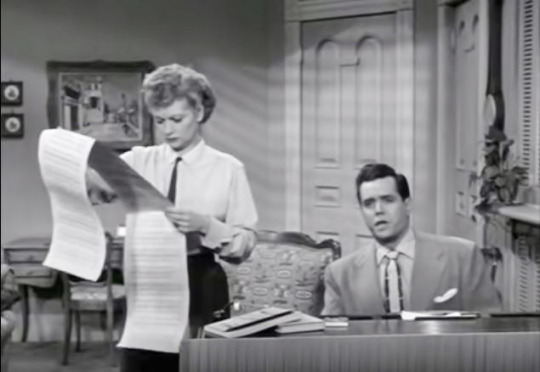
On television, the song was “Auf Wiedersehen, My Dear” with Lucy only allowed to sing the word “Auf”!
George agrees to find another opening song. They start to work on their comedy patter. While rehearsing the jokes, Liz realizes that George is telling all the jokes while she is the straight man not saying anything funny.
LIZ: “I’m Liz Cooper, not Harpo Marx!”

Harpo Marx (born Adolph Marx) was the second of five performing brothers. Harpo was so named because of his musical talent on the Harp, but he also never spoke in his comedy. In 1922, he and his brothers left vaudeville to perform on Broadway, and soon landed in Hollywood making movies together throughout the 1930s and 40s. Lucille Ball starred with the Marx Brothers in Room Service (1938) and Harpo famously guest-starred on “I Love Lucy” in 1955.
GEORGE: “What would Amos be without Andy? What would Lum be without Abner?”

Amos 'n' Andy is a radio and television sitcom set in Harlem. The original radio show, which ran from 1928 to 1960, was created, written and voiced by two white actors, Freeman Gosden (Amos) and Charles Correll (Andy). When the show moved to television, black actors took over the roles of Amos (Alvin Childress) and Andy (Spencer Williams). Lum and Abner was a radio comedy created by and starring Chester Lauck (as Abner Peabody) and Norris Goff (as Lum Edwards) that aired from 1931 to 1954. Modeled on life in a small town in Arkansas, the show proved immensely popular.
Liz says that since they are representing her club, she needs to have the larger role. George confesses that Mr. Atterbury wants him to represent the bank. Liz says the act is off. George says he find one of the girls at the bank to be his partner. Liz assumes the ‘girls’ at the bank are old fuddy duddies!
Next day, Miss Marilyn Williams (Gloria Blondell) arrives to rehearse. Her fuddy isn’t duddy at all! Liz tells Miss Williams that George left on a trip to South America. Just then, George bounds in and says he only went to put the car in the garage.
LIZ: “I always get confused. Our car is a Reo.”

Liz is punning on the homophones Rio (Rio de Janeiro, Brazil) and Reo (the make of automobile). Reo (sometimes seen REO) was founded by Ransom E. Olds in August 1904. Reo manufactured automobiles from 1905 to 1936, including the famous Reo Speed-Wagon, an ancestor of the pickup truck, which gave its name to the 1970s rock and roll group REO Speedwagon. Although World War II truck orders enabled it to make something of a comeback, the company remained unstable in the postwar era. In 1975, they filed for bankruptcy.
Miss Williams and George go into the den and close the door to rehearse while Liz and Katie listen on the landing just outside, peeking through the transom. They hear carefree laughter from the room. George and Miss Williams are rehearsing a love scene when Liz bursts in offering them a snack. Miss Williams says that Liz is acting jealous. Liz calls her an ‘older woman’.
MISS WILLIAMS: “You don’t have to get nasty with me, Liz Cooper. I’m not going to steal your son away.”
LIZ: “My son! Listen here, you poor man’s Marjorie Main!”
MISS WILLIAMS: “You start anything and I’ll black your eyes to match your hair!”
LIZ: “My hair is red.”
MISS WILLIAMS: “I’m talking about the roots!”

Marjorie Main (1890-1975) was then a 49 year-old character actress who earned a 1948 Oscar nomination for The Egg and I. In 1954 she was a supporting player in Lucy and Desi’s The Long, Long Trailer (1953).
Next day, Liz has invited over a handsome man (Gerald Mohr) to rehearse a ‘passionate love scene with her’. It turns out that George and Gerald were fraternity brothers! George decides to sit by and watch Liz and Gerald rehearse.

The scene is similar to Mohr’s appearance as a psychiatrist on “I Love Lucy,” where he flatters Lucy and inadvertently makes Ricky jealous as part of his ‘treatment’.
George tries to distract Gerald by asking about former fraternity brothers. George and Gerald think the love scene will get a million laughs, which makes Liz dissolve into tears.
The night of the Red Cross show, Liz tells Katie she’s going to be George’s partner no matter what! George is on right after Evelyn and Her Magic Kazoo. Liz tells Miss Williams that George wants to see her in his dressing room - then locks her in!
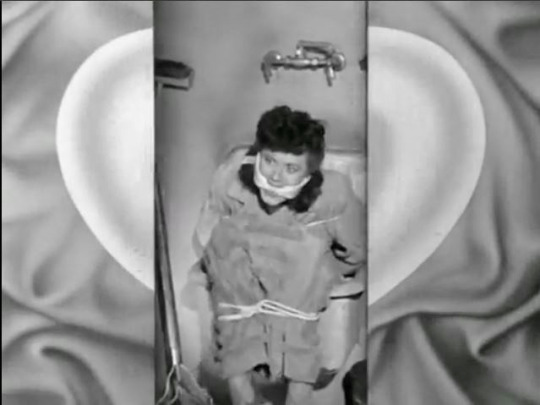
On an early episode of “I Love Lucy,” a jealous Lucy also locked her husband’s performance partner away - in a storage closet - so that she could take her place. Much later, an envious Lucy locked Tallulah Bankhead in a backstage bathroom so she could steal the spotlight during the Westport PTA show.
Liz tells George Miss Williams couldn’t make it and she will talk her place. They go onstage. The music connecting the jokes is "When You Wore a Tulip and I Wore a Big Red Rose".
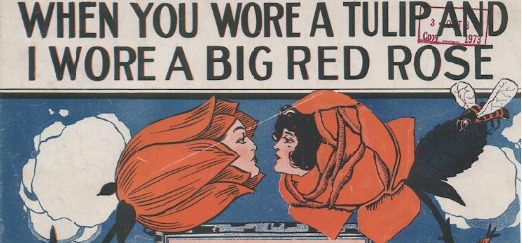
"When You Wore a Tulip and I Wore a Big Red Rose" was written in 1914 by Jack Mahoney and Percy Wenrich. At the time of broadcast (1949) it had been heard in sixteen films, including the 1942 film For Me And My Gal starring Judy Garland and 1949′s Chicken Every Sunday starring William Frawley (Fred Mertz). On “My Favorite Husband” it will also be heard in “Liz Writes A Song” (January 27, 1950).
This time, however, Liz has stolen all of George’s punch lines!
GEORGE: “A tramp came up to me and said he hadn’t had a bite in days.”
LIZ: “What’d you do? Bite him?”
GEORGE: “Did you hear about the big fire at the shoe factory?”
LIZ: “I’ll bet some heal started it!”
GEORGE (hushed to Liz): “You’re supposed to say ‘Who stated it’.”
LIZ (loudly): “Two hundred souls were lost!”
George tries to outsmart Liz with a joke she’s never heard.
GEORGE: “I know a girl so dumb she thinks a football coach has four wheels!”
LIZ: “How many wheels does it have?”
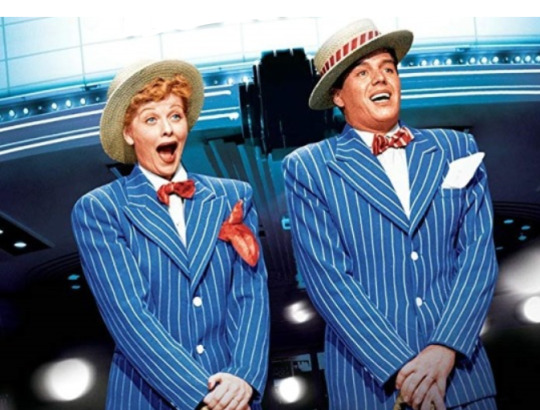
These are the same jokes that will be used in the television version “The Benefit” (ILL S1;E13) although the interlocutory music was changed to “We’ll Build A Bungalow”. The Arnazes loved the material so much that they started doing the "Songs and Witty Sayings" routine at various industry functions and charity events including the televised "Dinner with the President" event on November 25, 1953. The material was even part of the unreleased “I Love Lucy” movie.
End of Episode
#My Favorite Husband#The Benefit#I Love Lucy#Red Cross#Lucille Ball#Richard Denning#Gale Gordon#Ruth Perrott#Gloria Blondell#Gerald Mohr#Marjorie Main#Bob LeMond#Reo#Lum and Abner#Amos and Andy#Radio#CBS#Harpo Marx#Zing Went the Strings of My Heart#Bing Crosby#Drano#THere's NO business Like Show Business#Al Jolson#Boola Boola
0 notes